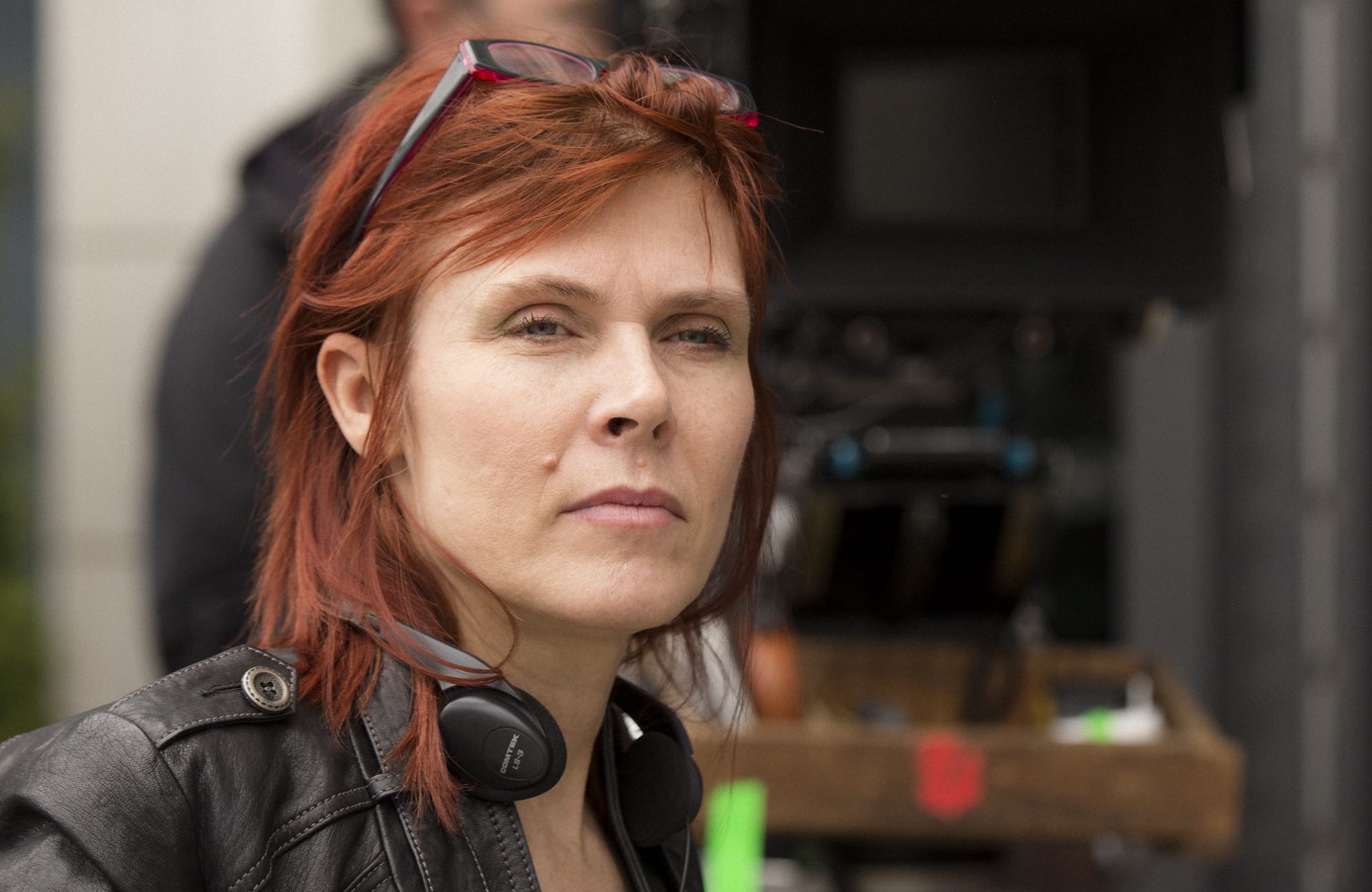Adrienne Mitchell is one of the principal owners and Executive Producer at Back Alley Film Productions, and an award-winning and proven dramatic director. Over her more than 20 year career, Mitchell has directed numerous dramas including episodes of the critically acclaimed CBC series Drop The Beat, and Straight Up, and Gemini-nominated erotic anthology series Bliss, all of which Mitchell co-created and executive produced.
Set Scouter: How did you get into directing and producing? Can you give us a bit of a rundown of your career?
Adrienne Mitchell: I studied at Ryerson in the film and photography program. I knew very early on, even in grade 12, that I wanted to be a director, so I found the right program for me, which was Ryerson’s. It was great, they allowed us to film short movies, get crews and actors together – so it wasn’t just theory and academia. They had a studio, they had edit facilities, mixing facilities, so you really got a good sense of production. That was a great education for me.
After that I joined LIFT – The Liaison of Independent Filmmakers of Toronto, where I was able to continue working on my directing and creating short films. And that’s where I met Janis Lundman who is my business partner. I got into directing working with Janis on a documentary called Talk 16, which followed 5 teenage girls over a period of a year. That got interest from CBC to do a drama series based on different youth cultures. On that series I had started off as a creative producer, but then on the second season I directed an episode – that was my first directing gig for television. From there we spun off into a hip hop series called Drop the Beat which I directed on as well. Our next series Bliss was a drama series written by women, directed by women and based on women’s erotica which was for Showcase and Oxygen. I showran that series with Laurie Finstad and Janis Lundman, and that spun off into darker territory with Durham County. We did three exciting seasons of Durham County where I was much more involved with directing, and starting to set the visual style of the show in seasons 2 and 3. I won a DGC award for my directing on Durham.
After Durham County was Bomb Girls, a project that I’m extremely proud of, set in a World War 2 munitions factory. With that I set the style from the very beginning and it was such a rewarding project. Following that I directed the pilot of a great undercover series called Played and I’m continuing to develop projects now where I’m gearing up to direct and set the visual style.
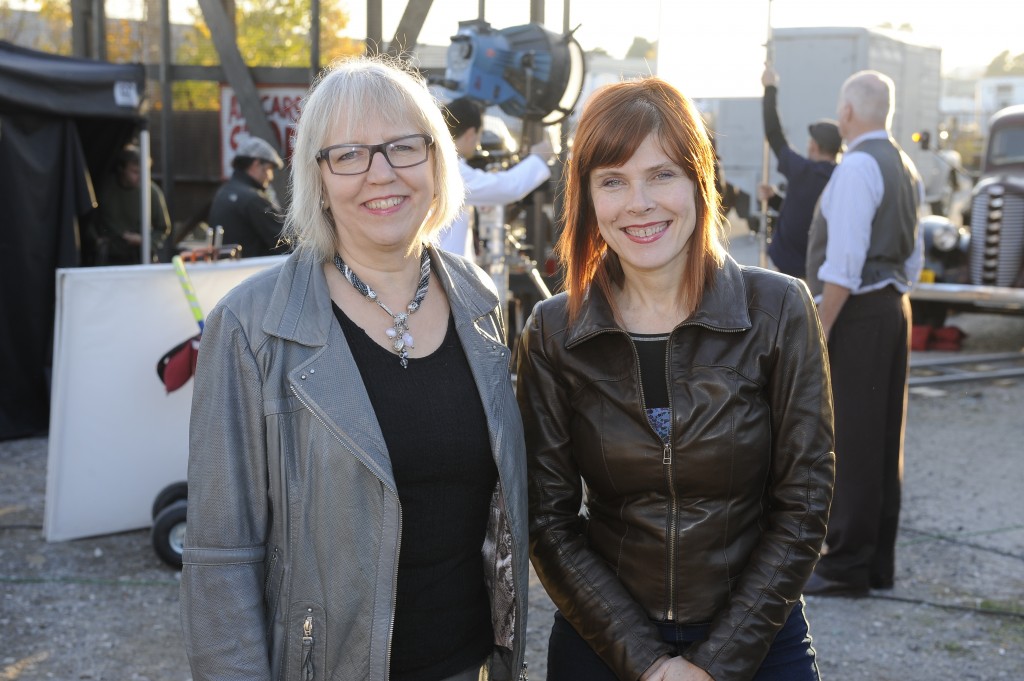
Adrienne (right) on set with her producing partner Janis Lundman (left).
Photo copyright Muse Entertainment Enterprises and Back Alley Film Productions.
Set Scouter: What are some of the biggest challenges you find yourself facing as a director?
AM: The biggest challenge for me is finding a writing partner where we can have a truly artistic collaboration. In television the creators lead the vision, but you need to have a collaborative spirit because so many people have to weigh in. It’s choosing the right partners that can collaborate without watering down their vision. As a director I need that in a writer because so many things come at you. You never have enough money, there are constant logistical challenges; so the beautiful script you created in the void before of the realities of production goes through changes. And you need someone who can kill babies but find a way to maintain the creative juice and intrigue of the project.
The next challenge is casting, because if you make a wrong move with the cast you’re lost. And all your hard work is pretty much lost. They are the animators of the show – they translate the show. It’s the director’s relationship with the actors that will create a character that will draw the audiences in and connect with audiences. And sometimes it’s very hard to know if you have the right actor. You go through auditions; you go through discussions with them. But you never really know until the first day on set and all the mojo is happening as to whether that actor is the right actor to convey the vision of the series. I’ve had successes – great successes, and I’ve had failures. The failures are so difficult, so I try to put in measures to prevent that. I do chemistry reads with other actors. I’ll bring them in for a few different scenes; try to throw surprising elements at them to make sure I feel I can work with them. Working with Meg Tilly was truly one of my most rewarding experiences – she’s so open and committed and has the courage to move into risky emotional terrain.
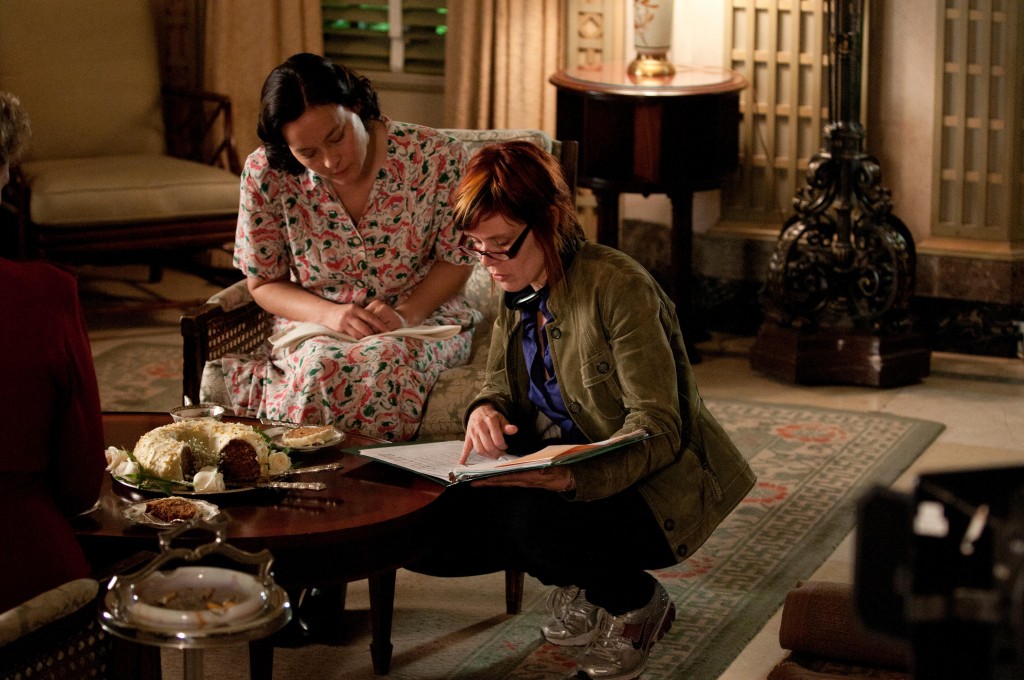
Adrienne (right) working with star Meg Tilly (left) on the set of Bomb Girls.
Photo copyright Muse Entertainment Enterprises and Back Alley Film Productions.
Set Scouter: Being a director as well as a producer do you find yourself having to balance those two roles? Is that difficult for you?
AM: It’s very difficult because I know what’s going on in my fellow producer’s mind when we’re going into overtime. I actually look forward to the time when I’m not producing as well, just to know what that feels like. Sometimes when you’re a producer it can cloud you a bit if you start worrying too much about money. But for any director you hire, you’re not going to hire them back if they blow the budget, so as a director you still need to be aware of the budget and find economic ways to do things. It’s all about those moments where you have to make decisions that work with the economy of the production without compromising the vision.
Set Scouter: As a director, how involved are you in choosing the locations for your series? Can you take us through your process?
AM: Locations, that’s my thing. Everything for me revolves around locations. They speak to me, they tell stories, and they show how the scene can progress. They’re very important. I try and get on board with a location manager very early on, and bring the writer on board too. When we go look at locations, I bring my handy camera, and sometimes have people walk around the space so I can get a sense of how the actors might move through it, to give me an idea of how to block a scene or shoot it. I’ll walk around and look at angles to connect to and feel if it’s something that works. I like locations with texture and depth, interesting angles. Then I often go back to the writer and say let’s look at that scene. When you’re writing to a location it changes things. Discoveries happen in ways that are very interesting so the location becomes a storyteller in a way.
Set Scouter: Can you share a specific time when that happened? Where you went to a location and it changed something important about the scene?
AM: In Durham County, which is largely set in a neighbourhood surrounded by hydro towers, there’s a big fight in season three between Michael Nardone who plays Ivan and Hugh Dillon who plays Mike Sweeney. They’ve just come from the hospital where Mike learned his wife died in childbirth, and Ivan delivered the baby and made the choice to save the baby over his wife. I saw this location underneath these huge hydro towers and I wanted Mike, when he left the hospital in a terror with Ivan and the cops following him, to drive towards these hydro towers and get our of his car and walk underneath the towers. In that way, the fight between Ivan and Mike would happen underneath these hydro towers. They were so eerie and there were more towers in the distance, and a road where you can see the cop cars coming in, and I thought let’s put it here. The fight between them changed a bit because it was set in this location – it had a different type of progression and different tone to it. The fight felt more raw and ugly and menacing because of the looming, dangerous presence of the hydro towers.
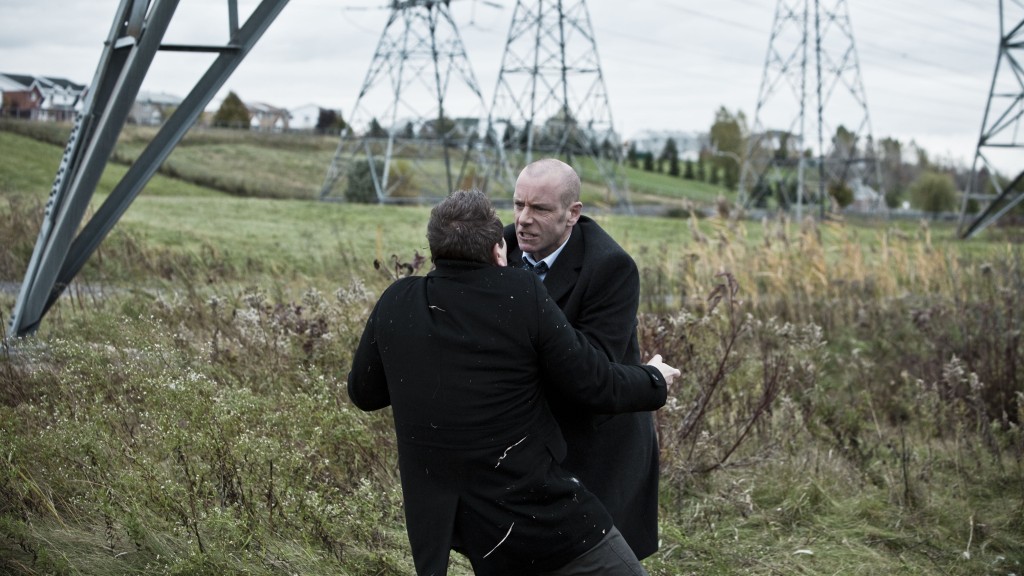
Mike (Hugh Dillon) [facing] and Ivan (Michael Nardone) fight under hydro towers on Durham County.
Photo copyright Muse Entertainment Enterprises and Back Alley Film Productions.
Set Scouter: Given your breadth of experience, do you have any advice for someone on their way up? What do you think is important for people that are getting started in the film and TV industry to know?
AM: The biggest thing I would say is you can’t go into this industry in a 60-70% way, it’s a 130% energy effort. If you want to do your own work you’re working day and night, seven days a week to get your projects off the ground. You’re going to suffer with your friendships; you’re going to suffer with your relationships. You need absolute dedication and passion as well as absolute drive. You can’t give up because you will get rejected over and over and over again, and told that what you’re doing is not going to happen. My other advice is to try and hook up with someone that can be there when things get tough to boost your morale and work with you in a partnership creatively and in the business end of things. And I was luckily enough to find that with my partner in Back Alley Films, Janis Lundman.
On the more practical side, making short films are great. You start to build your repertoire; you have material you can show. Start small, maybe try a documentary first, then from that you could jump to a documentary series, then something from that could lead to a drama. People like to know what you’ve done in the past and how it’s feeding and evolving as opposed to you just coming in with an idea and nothing else. It’s important to build a track record for yourself – even if it is through self-generated projects.
Set Scouter: What are you working on next?
AM: I’m developing this amazing crime series with an inspiring and talented young writer Jane Maggs that we’re developing with the UK and CBC. It takes place in an old mining town that is trying to rebuild itself with new industry when a local star hockey player goes missing. The hero of our series, Annie Reader, is one of the cops tasked with finding him. And what’s interesting is the disappearance is eerily linked to the disappearance and murder 20 years ago, of a girl who was an outcast in the town. What links the cases are these strange riddles that Annie receives that have some connection to the cases in the past and the present. So it’s all about her digesting these riddles and how they could help solve the current case and hopefully the cold case as well.
I’m also working on an exciting feature project written by Canadian novelist Helen Humphries. It’s called The Evening Chorus, and the novel’s due to be published in February. It’s set in WWII and is about a UK officer who, within 24 hours of being deployed is captured and thrown into a German POW camp. To escape the torture and strange boredom of the camp, he begins to record the behaviour of a pair of birds outside the prison walls. He’s attracting a lot of suspicion because people think he might be part of an escape plot, so he’s thrown into solitary and the German commandant realizes what he’s been up to. And they develop a strange unlikely relationship based on their love of Natural History. It also follows the story of the officer’s wife. He’s been writing but she hasn’t been writing back because unbeknownst to him she’s having a wild affair with a soldier back in her hometown. Part of the reason he reaches out to the commandant is because he can’t connect with her though his letters, so he’s forced to find some kind of bonding through this dangerous relationship. It’s a very interesting story about the extreme measures people will take to find human connection under adverse circumstances like war.
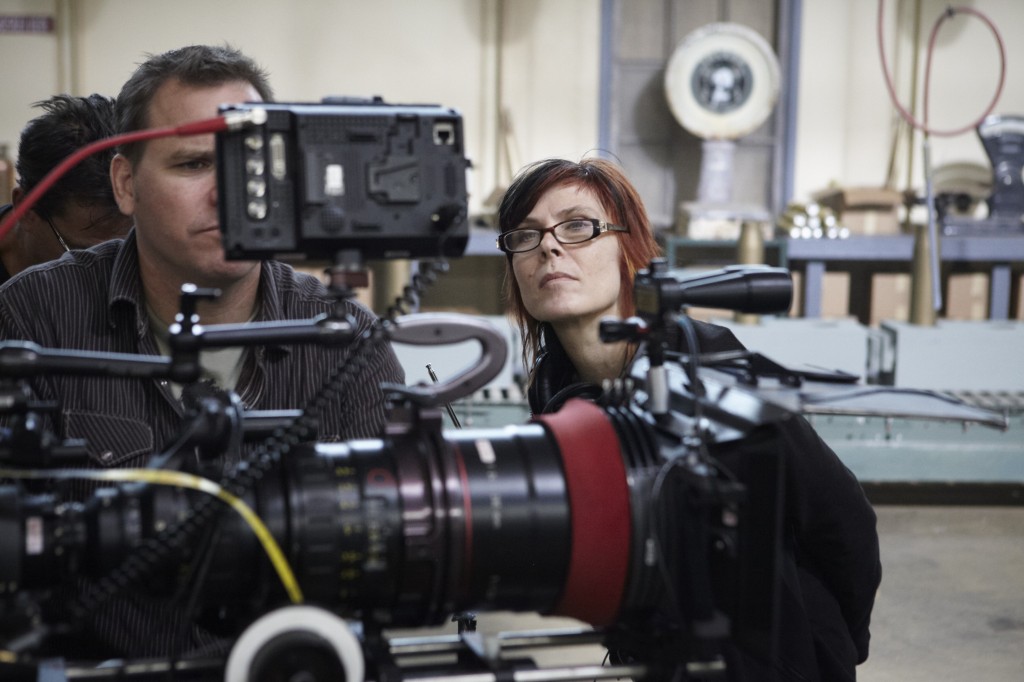
Adrienne directing on the Global TV series Bomb Girls.
Photo copyright Muse Entertainment Enterprises and Back Alley Film Productions.
It was really great talking with Adrienne and such an honour to have her share her knowledge with us. A big thank you from all of us at Set Scouter.

